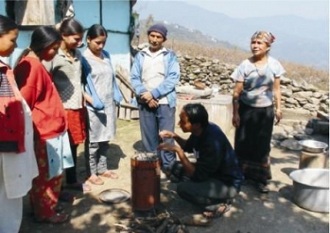Stove Performance Inventory Report, Prepared for the Global Alliance for Clean Cookstoves, 2012.
Berkeley Air Monitoring Group
The inventory currently contains data from over 600 unique sets of performance tests, which represent more than 3500 individual samples collected using a range of laboratory and field methods. It was compiled through a systematic review of published and gray literature using search terms related to cookstove testing and performance. The inventory has also been designed to facilitate continuous updates, so that additional sources, including new studies and foreign-language publications, may be included.
The purpose of this report is to present key information about the current inventory, breaking down the numbers by type of test, data source, region, and stove and fuel type. The bulk of the current inventory data is from laboratory tests, especially from North America and Asia, where a handful of large testing programs have been the main contributors. Although there is much less field data to present, the largest contribution of field data comes from Africa. Traditional and simple non-traditional stoves have been the most commonly tested stove types, with more testing now being done on newer stove technologies and fuels. Finally, the inventory substantiates the expectation that liquid and gas fuels burn more cleanly than solid fuels, whereas unprocessed crop residues and dung are generally the least clean household energy sources.
The stove performance inventory also provides an opportunity to map and compare stove performance against standards or benchmarks, the most relevant of which is the recently approved ISO International Workshop Agreement on Clean and Efficient Cookstoves (February 2012). The IWA, which is a preliminary step towards a formal ISO standard, uses “Tiers of Performance” to categorize stove performance levels for efficiency, safety, and emissions. The majority of non-traditional solid-fuel stove performance results place them in Tiers 1 and 2 for emissions and efficiency, with only liquid and gas stoves (e.g. ethanol and LPG) meeting the ambitious health and environmental-related targets associated with Tier 4. By and large, the best biomass stove performers – fan stoves and gasifiers – fit into Tier 3, although more data is needed to understand if these technologies can obtain similar levels of performance in the field.
Moreover, the comparison of laboratory and field data where both exist for specific stove/fuel combinations, which is generally for traditional (Tier 0) and Tier 1 stoves, indicates that laboratory testing overestimates the field performance for most stove types. The factors identified in the literature as having the greatest impact on the lab/field performance gap for biomass stoves are fuel quality and cooking as well as fire tending practices. This finding underscores the need for further field testing of advanced biomass stoves that fit into Tier 3 based on laboratory tests, to investigate whether this performance gap continues to exist in the higher tiers and if so, how it might be mitigated.
Although this first iteration of the inventory was compiled through the application of systematic search criteria and no doubt captures a great deal of the available work, there are some sources that are not represented and some topics that still need to be explored. Foreign language sources are missing, especially many Chinese papers, as are many proprietary data sets. Also missing are adoption-related metrics, as these are not yet well characterized. Finally, efforts still need to be done for mapping results from different water boiling-based protocols into a unified comparative framework, as well as the protocol development that would allow us to better include technologies not designed for typical water boiling testing, such as those for intended for cooking flatbreads (plancha) and indoor heating.



